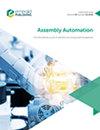Online modeling of environmental constraint region for complex-shaped parts assembly
IF 1.7
4区 计算机科学
Q3 AUTOMATION & CONTROL SYSTEMS
引用次数: 0
Abstract
Purpose The paper aims to propose a method to build environmental constraint region online in complex-shaped peg-in-hole assembly tasks. Design/methodology/approach Compared with conventional way which using computer-aided design (CAD) models of assembly parts to construct the environmental constraint region offline, the paper provides an online approach that consists of three aspects: modeling assembly parts through visual recognition, decomposing complex shapes into multiple primitive convex shapes and a numerical algorithm to simulate the peg-in-hole insertion contact. Besides, a contrast experiment is performed to validate the feasibility and effectiveness of the method. Findings The experiment result indicates that online construction takes less time than the offline way under the same task conditions. Furthermore, due to the CAD models of the parts are not required to be known, the method proposed in the paper has a broader application in most assembly scenarios. Originality/value With the improvement of customization and complexity of manufactured parts, the assembly of complex-shaped parts has drawn greater attention of many researchers. The assembly methods based on attractive region in environment (ARIE) have shown great performance to achieve high-precision manipulation with low-precision systems. The construction of environmental constraint region serves as an essential part of ARIE-based theory, directly affect the formulation and application of assembly strategies.复杂形状零件装配环境约束区域的在线建模
目的提出一种在复杂形状桩孔装配任务中在线建立环境约束区域的方法。设计/方法论/方法与传统的利用装配零件的计算机辅助设计(CAD)模型离线构建环境约束区域的方法相比,本文提供了一种在线方法,该方法包括三个方面:通过视觉识别对装配零件建模,将复杂形状分解为多个原始凸形状,并采用数值算法模拟桩孔插入接触。此外,通过对比实验验证了该方法的可行性和有效性。实验结果表明,在相同的任务条件下,在线构建比离线构建耗时更少。此外,由于零件的CAD模型不需要已知,本文提出的方法在大多数装配场景中都有更广泛的应用。独创性/价值随着制造零件的定制化和复杂性的提高,复杂形状零件的装配越来越受到许多研究人员的关注。基于环境中吸引区域的装配方法在低精度系统中实现高精度操作方面表现出了良好的性能。环境约束区域的构建是ARIE理论的重要组成部分,直接影响装配策略的制定和应用。
本文章由计算机程序翻译,如有差异,请以英文原文为准。
求助全文
约1分钟内获得全文
求助全文
来源期刊

Assembly Automation
工程技术-工程:制造
CiteScore
4.30
自引率
14.30%
发文量
51
审稿时长
3.3 months
期刊介绍:
Assembly Automation publishes peer reviewed research articles, technology reviews and specially commissioned case studies. Each issue includes high quality content covering all aspects of assembly technology and automation, and reflecting the most interesting and strategically important research and development activities from around the world. Because of this, readers can stay at the very forefront of industry developments.
All research articles undergo rigorous double-blind peer review, and the journal’s policy of not publishing work that has only been tested in simulation means that only the very best and most practical research articles are included. This ensures that the material that is published has real relevance and value for commercial manufacturing and research organizations.
 求助内容:
求助内容: 应助结果提醒方式:
应助结果提醒方式:


